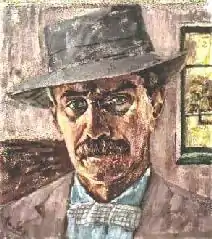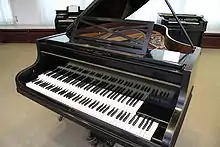Emánuel Moór
Emánuel Moór (Hungarian pronunciation: [moːr]; 19 February 1863 – 20 October 1931) was a Hungarian composer, pianist, and inventor of musical instruments.


Moór was born in Kecskemét, Hungary, and studied in Prague, Vienna and Budapest. Between 1885 and 1897 he toured Europe as a soloist and ventured as far afield as the United States. Besides five operas and eight symphonies his output also included: concertos for piano (4), violin (4), cello (2), viola, and harp; a triple concerto for violin, cello, and piano; chamber music; a requiem; and numerous lieder. Moór's opuses total to 151 to his credit including eight symphonies.[1] He died, aged 68, in Chardonne, Switzerland.
His best-known invention was the Emánuel Moór Pianoforte,[2] which consisted of two keyboards lying one above each other and allowed, by means of a tracking device, one hand to play a spread of two octaves.[3] The double keyboard pianoforte was promoted extensively in concerts throughout Europe and the United States by Moór's second wife, the British pianist Winifred Christie.
In 1921, Marie Tutundjian [de Vartavan] (born de Jarowslawska, 18.05.1887-20.11.1963) takes a large part in the experiments of the Duplex-Coupler piano imagined by Emánuel Moór. Marie is a very talented pianist who has been playing in public since the age of twelve and has even had the privilege of playing in duet with Paderewski Ignacy Jan Paderewski. She is married to the Armenian WWI hero and writer Levon Tutundjian [de Vartavan] and lives in Lausanne with him in Cornette de Bise. She teaches at the Ribeaupierre Institute, a higher music school in Lausanne founded in 1915 by Mathilde and Émile de Ribeaupierre. The same year Emánuel Moór sparks a lively controversy in the world of music by presenting two revolutionary inventions in quick succession. First, "a giant violin, one and a half meters long, with five to six strings to reach the length of the cello, the bow being moved by a pedal". The possibility of his employment in the orchestra prompted ironic comments from a critic of the Lausanne Gazette. Marie, for her part, worked with Moor's wife, Winifred Christie, to operate the second invention, a piano with two keyboards, the lower keyboard of which has its raised white keys to allow chromatic glissando and a pedal intermediate coupling the two keyboards - not to mention an ingenious system which made it possible to imitate a harpsichord. Marie Tutundjian played with it on 03-11-1921 at the Palace of Montreux and at least once again on 16-11-1921 [La Musique dans le Canton de Vaud (1904-1938), p. 146. See pages 251, 252 on Marie Tutundjian/de Jarowslawska], but these trials, if they leave a trace in music history are not repeated [Encyclopédie de la musique, 2e partie, vol. 3, p. 2080-2081].
Maurice Ravel said that the Emánuel Moór Pianoforte produced the sounds he had really intended in some of his works, if only it had been possible to write them for two hands playing on a standard piano.[4] Anatoly Brandukov, dedicatee of Moór's Cello Sonata, No. 2 in G Major, Op. 55, introduced the composer to Pablo Casals.[5] Casal's first meeting is recorded in nearly every biography about Casals. In his own words Casals said, “His music was overwhelming….and the more he played, the more convinced I became that he was a composer of the highest order. When he stopped, I said simply, ‘You are a genius.’”[6] This meeting was the beginning of a long friendship between the two with Casals performing and premiering Moór's compositions, several of which were dedicated to Casals. For example, Casals gave four performances of the Cello Sonata No. 2 in G Major in December 1905 alone following his initial meeting with the composer earlier in the year. Casals's first noted performance of this sonata came during a Russian tour (pianist not noted) followed by two performances with Marie Panthès in Geneva and Lausanne and one performance in Paris with Alfred Cortot at the piano.[7] Casals also championed other of Moór's works, performing multiple sonatas, a concerto that Moór dedicated to him, a double cello concerto, and a triple concerto for piano trio with orchestra.
Moór and Christie also collaborated on a book of technical exercises for the instrument.
Notes
- "Klassika: Works Sorted by Opus Number" (in German)
- Sometimes referred to as the Duplex-Coupler Grand Pianoforte, but this name was not one that Moór himself ever used.
- "The Bechstein-Moor Viola". Archived from the original on October 27, 2009. Retrieved 2009-11-26.CS1 maint: bot: original URL status unknown (link) at uk.geocities.com
- Grove's Dictionary of Music and Musicians, 5th ed., 1954, Eric Blom ed.
- Liessmann, Shoshana (17 May 2017). Emanuel Moór Erinnert. München: Henrik und Emanuel Moor Stiftung. p. 150.
- Joys and Sorrows; Reflections by Pablo Casals as Told to Albert E. Kahn, Pablo Casals, Simon and Schuster, New York (1973) ISBN 0-671-20485-8, pp. 138
- Kirk, HL (1974). Pablo Casals. Holt, Rinehart and Winston. p. 208.
External links
- Biography and list of works (in German)
- An article from the New York Times about the Duplex-Coupler Grand Pianoforte
- Emanuel und Henrik Moór foundation (in German)
- Free scores by Emánuel Moór at the International Music Score Library Project (IMSLP)
- Audio recording of Moór playing a "Hungarian Melody", recorded 1889 (Thomas Edison National Historical Park)
- Library of Congress Name Authority File
- WorldCat Identities
- Boston Symphony Orchestra Program Archives - See Page 34 for bio. His piano concerto, Op 57 was performed (pre-duplex coupler piano).